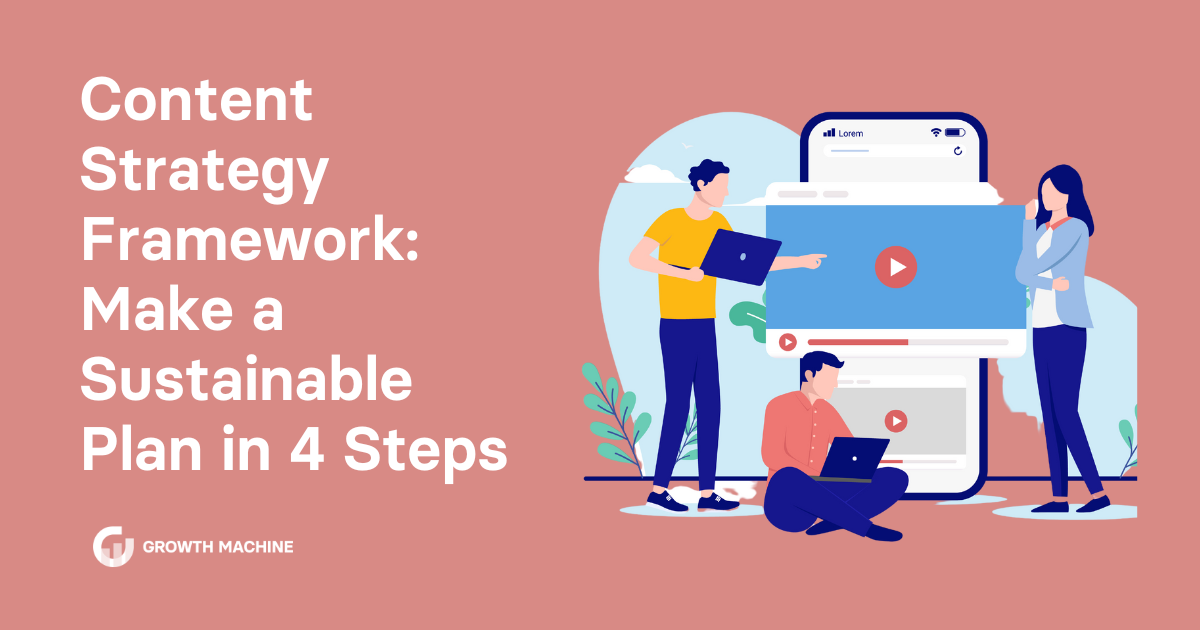Content Strategy Framework: Make a Sustainable Plan in 4 Steps
Intentional messaging that resonates with your audience is the bedrock of any good content marketing campaign. But with all the mediums and trends out there, how can you come up with a content strategy that will help you achieve your business objectives?
A content strategy framework is the answer. It’s a plan you use to outline your business goals — including your SEO strategy — as well as the types of content you will create along the way to achieve these objectives. By creating a framework like this, you ensure every piece of content you make aligns with your KPIs and overall brand identity.
We’re here to help you out with a step-by-step guide to creating the best possible content strategy for your business. You’ll need to:
- Define your identity.
- Choose your channels.
- Generate content ideas.
- Execute your strategy.
1. Define Your Identity
To create a content strategy framework, you need to know who you are as a brand. Without this sort of company self-knowledge, you’ll have a hard time managing your existing content, let alone planning for new content.
Ask yourself how you stand out in your industry and what makes you unique. Evaluate your current content to see what’s working and what’s not. Consider your customers and their journey, demographics, and personas. This will help you create a more tailored approach to your content creation.
When you know who you are and — just as importantly — who your customers are, the puzzle pieces will all start to fit together intuitively. You’ll be able to create a template for action based on differentiating yourself from your competition, addressing pain points for your customers through content, and targeting the right audience for your offerings.
These are just some of the things you’ll need to keep in mind when it comes to building a content strategy framework around your brand identity:
- Ask how you stand out. There are a lot of companies out there and, unfortunately, that usually means there are companies out there doing something similar to what yours does. You just need to show customers how you do it better. The easiest way to do that is creating content to appeal to your target audience through building a strategy framework ahead of time. Otherwise, you’ll just be wasting time on half-baked ideas when it comes to lead generation.
- Consider your customers. As you build your strategy framework, keep each aspect of the customer journey in mind. Think about how you’ll appeal to different demographics at each phase of the process, from first exposure to your brand to the eventual conversions you desire. This will often mean creating customer personas and conducting market research. The more info like that you have to inform your content framework, the better.
- Set problem-solving goals. You and your team will need to engage in constant ideation at each phase of the content strategy framework development process. That means predicting pain points ahead of time and being able to fix issues as they arise after you implement your strategy. Figure out the sorts of problems you want to solve for your customers, and then decide how you’ll solve the problems in your own content marketing framework to get there.
2. Choose Your Channels
To make the most of your content marketing efforts, you’ll need to tailor all your SEO-optimized posts, blogs, and other offerings to a wide array of different formats. In today’s digital ecosystem, customers expect to engage with you in a litany of different ways. Your job is to figure out which of these distribution channels has the greatest effect.
Keep these tips in mind as you build your strategy to attack the channels your customers use the most:
- Ask where your customers are. When you understand what your customers need, you’ll figure out what your content needs to succeed at the same time. Figure out which distribution channels your target audience takes the most advantage of. Your framework should place the greatest possible emphasis on serving up relevant content to your audience where they spend the most time.
- Find the right CMS. Consider the wide variety of content management systems on the market to help you put your plan into action. A content strategy framework is how you build a digital content strategy from the ground up. A content management system, on the other hand, is the all-in-one tool you’ll need to put those actionable steps into motion.
- Tailor your strategy to each platform. Identify the platforms where your customers are. Focus on the ones most relevant to achieving your business objectives. You’ll want to generate brand awareness in a way that’s unique to each channel. A detailed infographic might work better on LinkedIn than on Instagram, for instance. Successful content marketing frameworks take multiple platforms into consideration.
3. Generate Content Ideas
To meet your content goals, it goes without saying you’ll need to turn your company into an idea machine. Think of your content strategy framework as a Christmas tree. It’s the foundation upon which you’ll hang all the ornaments. The only catch is: When it comes to content, no ornament is premade. You’ll need to generate each type of content yourself.
Here are a few tips to fall back on when it comes to brainstorming content ideas:
- Create a content calendar. Build out an editorial calendar specifying all your content goals, as well as which types of content will get published when. Once you have this sort of schedule, you’ll be able to see firsthand which gaps you need to fill. Find a balance between content creation and distribution along the way too. You’ll want to give both your creative and digital marketing teams breathing room so they can perform to the best of their abilities.
- Focus on your customers. Never forget to prioritize your target audience when it comes to content planning. As you generate content ideas, always keep in mind who you’re writing them for in the first place. Do they come to you for comprehensive guides or quick tips? Do they want to see pop culture references or academic studies, or both? Do they want to post a Tweet thread summing up what they learned or make a TikTok? Plan your content strategy around your customer case studies and personas.
- Use different content formats. Make sure to generate ideas for all sorts of different content. You’ll want to have everything from social media and blog posts to whitepapers and case studies ready to go, depending on the kind of business you run. As just one example, a B2B marketing funnel will keep your content team busy for a very long time.
4. Execute Your Strategy
Up till this point, building a content strategy framework has been largely theoretical. Now, you’ve reached the point where you can put it all into action.
As you rev up the engine on your marketing plan, you’ll see just how much you’ve stood to gain from developing this sort of framework. You’ll have tools at your disposal for tracking content performance, while also automating huge portions of your creative and strategic work. Not to mention, you’ll have everything in place to pivot if need be.
Even the best laid plans and most ironclad strategies may need some tweaking once they hit the real world. It gets messy out there! Luckily, you’ll be far better equipped to handle any ups and downs with such a robust set of content ideas and initiatives to fall back on.
Consider these steps as you execute your strategy:
- Automate the process. Use interactive tools like Mailchimp, HubSpot Marketing Hub, and Sprout Social to automate your workflow as much as possible. As you look at the content strategy template you’ve built, think about how you can put your plan into action with as little work as necessary. It’ll free you up to work on higher-level problems.
- Monitor your metrics. Conduct content audits regularly to make sure all your different offerings are hitting your KPIs. Tools like Google Analytics can help you get an up-close look at what’s working and what isn’t. Your strategy framework lays the groundwork to achieve conversions, but you’ll still need to think on your feet to change things up in the real world.
- Remember to optimize. As you get the ball rolling with turning your strategy template into a reality, remember there’s still work to be done on a lot of different levels. You have a plan for all your content — that’s more than a lot of businesses can say! But still, you need to optimize posts that don’t perform super well to keep those conversions rolling in.
A Content Strategy Framework Can Set You Up for Success
With a far-reaching and holistic approach to your content strategy, you can set your brand up for success on every possible metric. Paired with top-of-the-line search engine optimization, frameworks like these are key to maximizing organic traffic to your various products and offerings.
Creating a comprehensive framework for your content creation may seem like a heavy lift up front, but it’ll reduce your workload for years on end once it’s up and running. Don’t have time to figure all of this out yourself? Contact us and we’ll set you up with an SEO strategy to flesh out any framework you’re starting to build.







